Here you will find a review of Teknetics Omega 8500 metal detector. From the article you will find out about what differs this model from other metal detectors in the product line, what operating frequency the device uses, what kind of searchcoil it has, if headphones are included into the device package set, how long it works using one battery set and other important information.
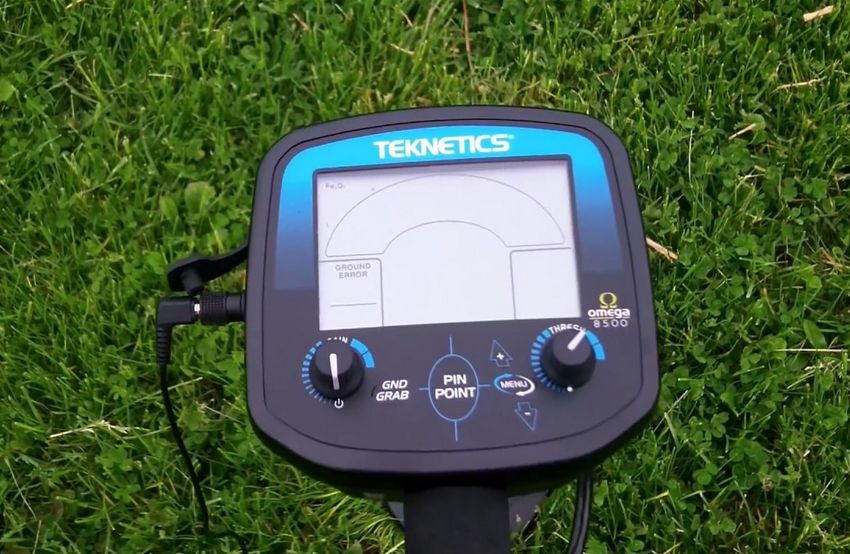
Contents
What was the device designed for?
Teknetics Omega 8500 metal detector is a flagship model of the product line (Alpha 2000, Delta 4000, Gamma 6000 are also devices from this product line). This is a semi-professional ground search metal detector with a full set of functions: discrimination, 4 sound tones, pinpoint, VDI, manual ground balance, GROUND GRAB function, displaying soil mineralization level on the LCD, etc.
| Model | Teknetics Omega 8500 |
| Weight | 2.5 lbs (1.1 kg) |
| Length (Adjustable) | 43” – 53” |
| Batteries | 9-Volt Alkaline (not included) |
| Headphones | Not included |
| Warranty | 5 years |
| Operating Principle | VLF |
| Standard Searchcoil | 10” (25 cm) Concentric |
| Operating Frequencies (kHz) | 7.69 kHz |
| Water resistance | Waterproof coil |
| Submersion Depth | No |
| Discrimination | 8 Categories + Notch |
| Ground Balance | Yes |
| Audio Threshold | Yes |
| Sensitivity/Depth Adjustments | Yes |
| Electronic Pinpointing | Yes |
| VDI (0 to 99 scale) | Yes |
| Build-in flashlight | Yes |
- Advanced Target Identification: The Teknetics Omega 8500 metal detector features…
- 10″ Concentric Searchcoil: Equipped with a high-performance 10″ concentric coil,…
- Computerized Ground Balancing: The Ground Grab automatic ground balancing system…
- Pinpoint Mode and Depth Indicator: The pinpoint mode provides an audio signal…
- Customizable Settings: The Omega 8500 offers adjustable sensitivity,…
Last update on 2025-06-10 / Affiliate links / Images from Amazon Product Advertising API / Source: Amazon Affiliates
The review
The shaft
The Teknetics Omega 8500 features a thoughtfully designed three-section shaft that enhances user comfort and functionality. Unlike earlier models, the control unit is mounted on a specially designed handle covered with polyurethane, rather than attached to the upper shaft section. This design choice improves accessibility and ease of use during extended detection sessions.
The upper shaft section includes an adjustable armrest with a cuff, which comes standard with the device. Users can shift the armrest along the shaft, allowing for a customizable fit to their individual parameters, thus enhancing comfort during operation.
Both the upper and middle shaft sections are constructed from a lightweight aluminum alloy, coated with durable powder paint to resist wear. The lower shaft section is made from solid plastic (carbon), ensuring that the detector maintains its appearance even after prolonged use.
The middle shaft section features eight adjustment holes, enabling users to tailor the shaft length to their height for optimal comfort. Assembly is straightforward, utilizing spring buttons for preliminary fixation and camlocks with swivel washers for secure locking.
When fully assembled, the Teknetics Omega 8500 weighs a manageable 2.3 pounds, making it an excellent choice for those seeking a lightweight yet durable metal detector.
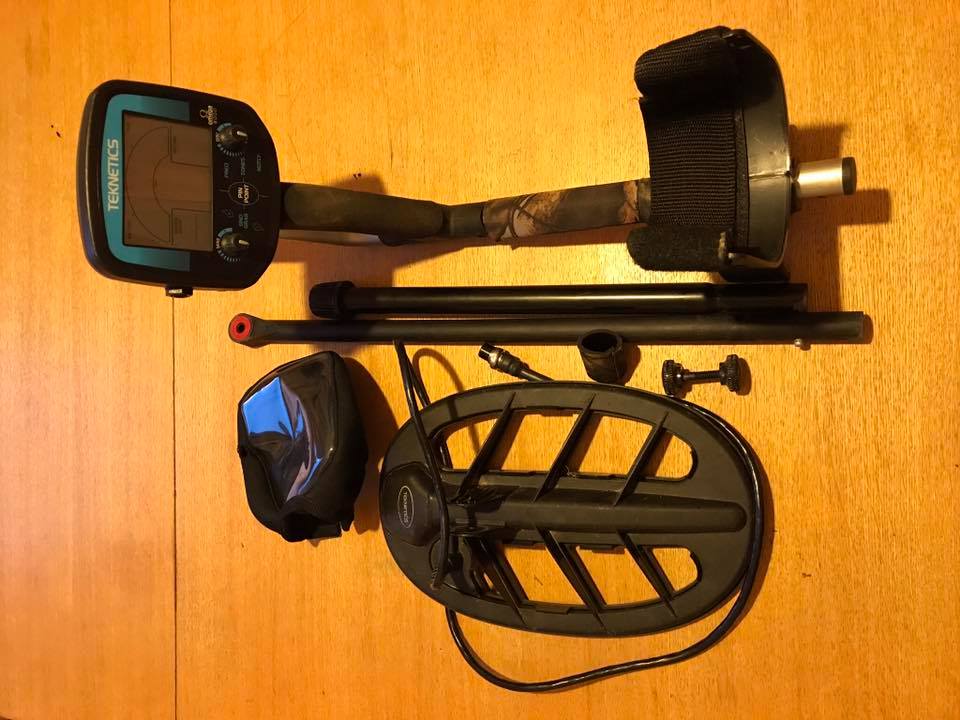
The searchcoil
The Teknetics Omega 8500 operates at a frequency of 7.8 kHz, making it suitable for detecting a wide range of metal types, including coins, jewelry, and relics. This frequency strikes a balance between depth penetration and sensitivity, allowing users to effectively target both small and large objects. The detector comes with an 11-inch elliptical concentric coil, which is included in the standard package.
This search coil is housed in a robust monolithic plastic case that provides excellent protection against impacts and wear, ensuring its durability. Additionally, the case makes the coil completely waterproof, allowing users to search in wet conditions without concern.
The search coil’s cable is designed with a thick elastic braid that remains flexible even in low temperatures, preventing it from becoming stiff and unmanageable. To secure the cable along the shaft sections, two soft clamps made of touch-and-close fasteners are employed, keeping everything organized during use.
A notable feature of the jack plug is its threaded swivel nut, which prevents accidental disconnection during treasure hunting, ensuring a seamless experience. Importantly, the design of the search coil eliminates the need for any additional protective gear, as its monolithic plastic case safeguards the sensor from wear and moisture ingress.
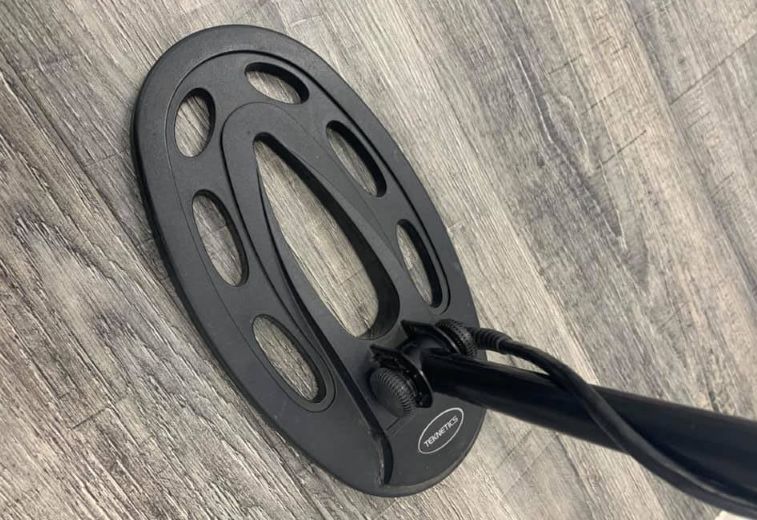
The headphones
Headphones are not included in the Teknetics Omega 8500 metal detector’s package, but the device is equipped with two input jacks located on the left side of the control unit. This allows users to connect any kind of stereo headphones, providing a more immersive and focused listening experience while detecting.
Additionally, the back of the control unit features a battery holder, ensuring that users can easily access and replace batteries as needed. This thoughtful design consideration enhances the overall user experience by allowing for quick battery changes during extended treasure hunting sessions.
The battery
The Teknetics Omega 8500 metal detector is powered by a single 9V battery. Under normal temperature conditions, one alkaline battery provides up to 20 hours of continuous operation, allowing for extended treasure hunting sessions without frequent interruptions. Notably, if users connect headphones, the operation time may increase further, enhancing the overall experience.
Alternatively, users can opt for rechargeable batteries, although this choice results in a shorter operational time of approximately 8 to 10 hours. While using rechargeable batteries may require more frequent recharging, it offers a sustainable option for environmentally conscious users who prefer to minimize waste.
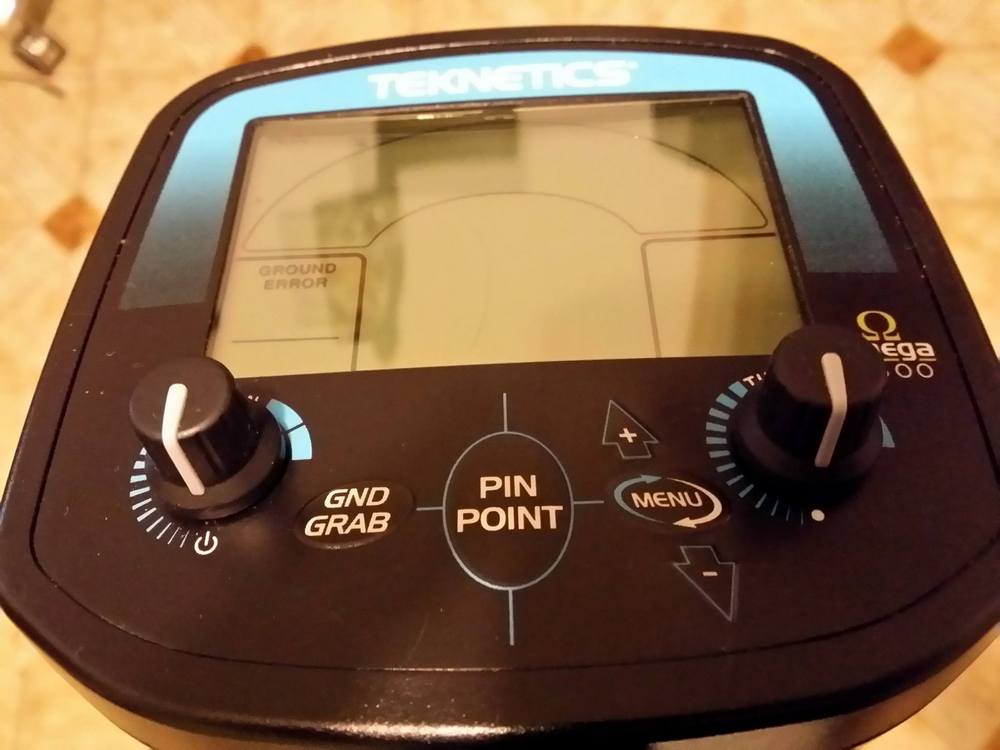
The control unit
The control unit of the Teknetics Omega 8500 is securely fixed to the handle, making it both sturdy and convenient. Its compact design allows for easy transport and storage in a standard backpack, making it an ideal choice for metal detecting enthusiasts on the go.
Located beneath the display are several control elements, including two potentiometers and seven touch-sensitive buttons, which are discreetly hidden under a protective plastic panel. This design feature helps prevent dirt and dust from interfering with the device’s functionality.
The left potentiometer serves dual purposes: it powers the device on and off and adjusts the sensitivity level of the metal detector, allowing users to tailor their settings based on the specific detecting environment.
The right potentiometer also has two functions. When turned counterclockwise until it clicks, the metal detector switches to AUTO TUNE mode. This mode automatically adjusts the device’s response to targets, simplifying the searching process for users.
Between the potentiometers are buttons designed for specific functions. The “+” and “-” buttons, along with the GND GRAB button, are used to adjust the ground balance function, ensuring optimal performance in various soil conditions.
The PINPOINT button activates a static mode that helps users detect the center of a target more accurately, enhancing the efficiency of their searches.
On the right side, the FREQ button allows users to adjust the operational frequency of the metal detector, while the TONES button enables users to change the number of tones in the response signal, providing customizable audio feedback. Lastly, the NOTCH button activates a mode of selective discrimination, allowing users to filter out unwanted metal types, enhancing their detecting experience.
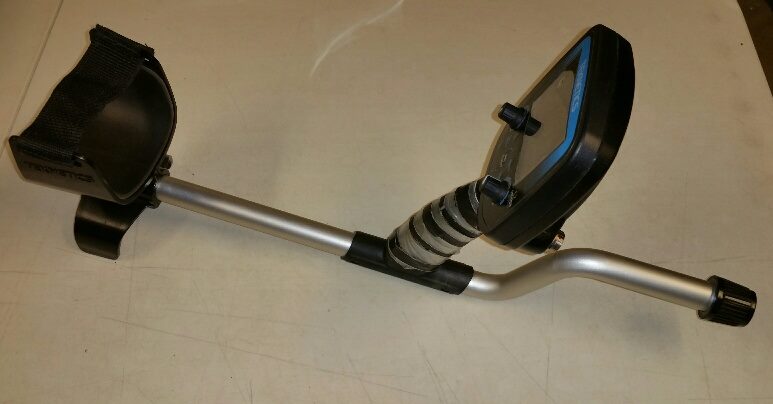
Search modes
The Teknetics Omega 8500 metal detector features two primary search modes: Discrimination mode and All Metal mode. Users can easily switch between these modes using the potentiometer located on the right side of the control unit.
In Discrimination mode, users have the option to adjust the discrimination scale, which is visually represented as a semicircular diagram on the display. This allows for precise discrimination of metals, enabling users to eliminate unwanted targets. The NOTCH mode lets users discriminate metals one at a time or select from eight specific discrimination segments, effectively filtering out targets that are deemed unnecessary.
As users exclude discrimination segments sequentially, the detector will initially stop detecting metal objects with the lowest conductivity. For instance, foil will be excluded from detection before moving on to other metals. However, there are instances where users might need to exclude a specific type of target, such as bullets. The NOTCH mode is particularly useful in these cases, allowing users to remove unwanted objects while retaining those with both low and high conductivity.
Many professional diggers prefer using All Metal mode, as it provides signals from all metal objects without any tonal differentiation. Although this mode does not offer distinct tones for different metals, it allows for identification through visual indications on the digital display. When in All Metal mode, the detection depth of the device significantly increases since target signals bypass all filtering processes and are displayed directly on the LCD.
The main visual indicator is the VDI (Visual Discrimination Indicator) number, which appears as a two-digit number in the center of the LCD display. A VDI number close to zero suggests the presence of an iron object, while a number nearing 90 indicates a higher likelihood of a target made from materials like silver or copper.
Each VDI number corresponds to a specific target sector, and these sectors are marked with symbols that provide approximate characteristics of the group of objects that may include the detected item. This feature aids users in making more informed decisions during their metal detecting endeavors.
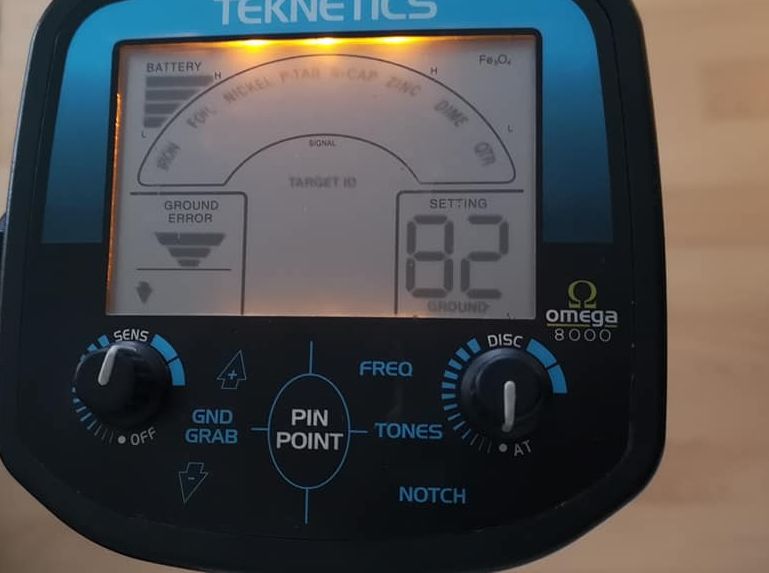
Sound tones
The Teknetics Omega 8500 metal detector can produce a maximum of four response signal tones, allowing users to easily identify different types of metal targets. The lowest tone corresponds to targets made of iron, while the highest tone indicates targets with high conductivity, such as silver or gold coins.
For those who prefer a simpler auditory feedback system, the number of response tones can be adjusted. Users can opt to reduce the tones to just two: one tone will signal the detection of an iron target, while the other will alert the user to the presence of non-ferrous metals and alloys. This flexibility allows users to tailor the audio response to their preferences, enhancing their overall detecting experience.
Threshold
The Teknetics Omega 8500 metal detector features a constant background sound known as the threshold tone, which helps users distinguish between desirable and unwanted targets. This threshold tone provides a continuous audio signal that serves as a baseline for detecting changes in the environment.
When activated, the threshold tone emits a steady noise. Users can closely monitor how this sound fluctuates, which can indicate the presence of deeper or smaller metal objects that may not produce a detectable signal on their own due to their physical properties or positioning within the ground. By paying attention to the variations in the threshold tone, users can make informed judgments about the types of metal objects potentially buried beneath the surface, enhancing their overall detection effectiveness.
Ground balance
The detection depth of the Teknetics Omega 8500 metal detector is significantly influenced by its properly adjusted ground balance function. Unlike metal detectors with fixed ground balance values that typically yield average detection depths, the Omega 8500 excels in delivering superior performance.
This device allows for both automatic and manual adjustments of the ground balance, catering to various conditions and user preferences.
Additionally, the Teknetics Omega 8500 is equipped with multiple systems to monitor ground parameters. For instance, users can assess soil mineralization levels by observing the scale located in the top right corner of the display. This feature enables users to evaluate the potential of their search area before making any adjustments to the metal detector settings, enhancing the overall effectiveness of their treasure hunting efforts.
Noise cancel
The Teknetics Omega 8500 includes an essential feature for treasure hunters working in areas with electromagnetic interference, such as near power transmission lines or underground utility systems. Users can easily shift the operating frequency at any time to minimize noise and maintain effective performance.
This frequency adjustment does not compromise the metal detector’s performance; instead, it helps eliminate unwanted electrical noise, allowing users to focus on their search. This function proves particularly beneficial in environments where multiple Teknetics metal detectors are operating on the same frequency or during competitive digging events, ensuring a clearer detection experience.
Conclusions
The Teknetics Omega 8500 metal detector stands out as a versatile and user-friendly device, suitable for both beginners and seasoned treasure hunters. Its quiet operation and responsive target detection ensure a focused searching experience, allowing users to hone in on valuable finds without unnecessary distractions. The advanced discrimination feature provides accurate identification of targets, enhancing the efficiency of searches and minimizing the chances of digging up unwanted ferrous materials.
The ability to adjust ground balance automatically and manually significantly improves detection depth, making the Omega 8500 effective in various soil conditions. Additionally, the straightforward controls and intuitive design make it accessible, enabling users to quickly adapt to its functionalities.
Garrett ACE 400 or Fisher F44 may be considered as an alternative devices to this one.
